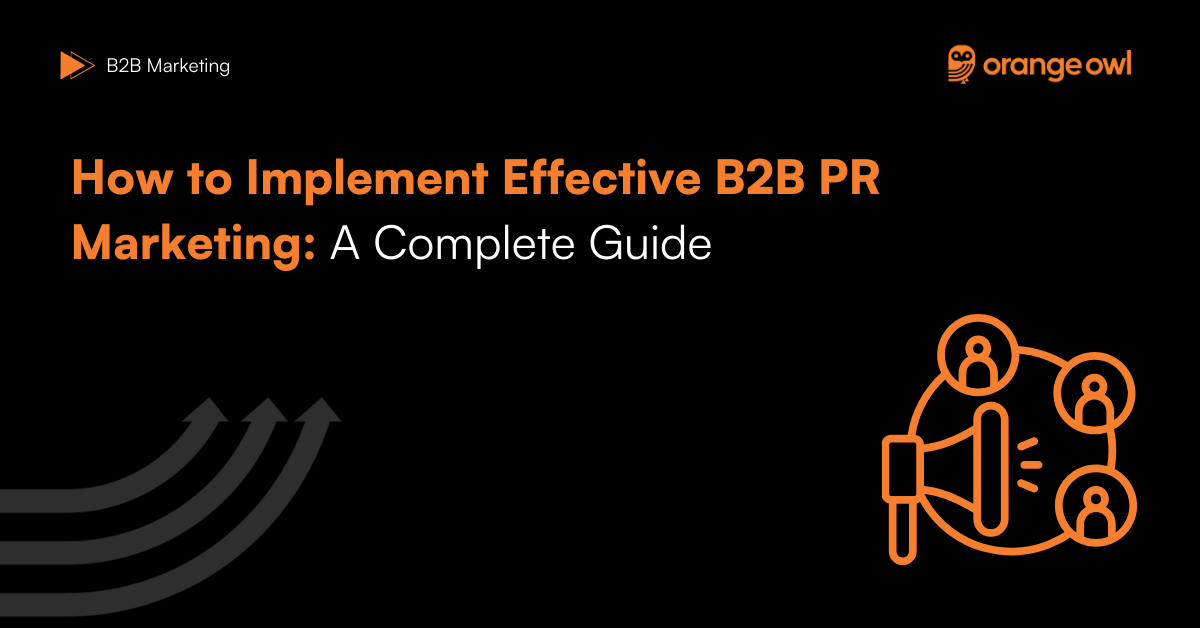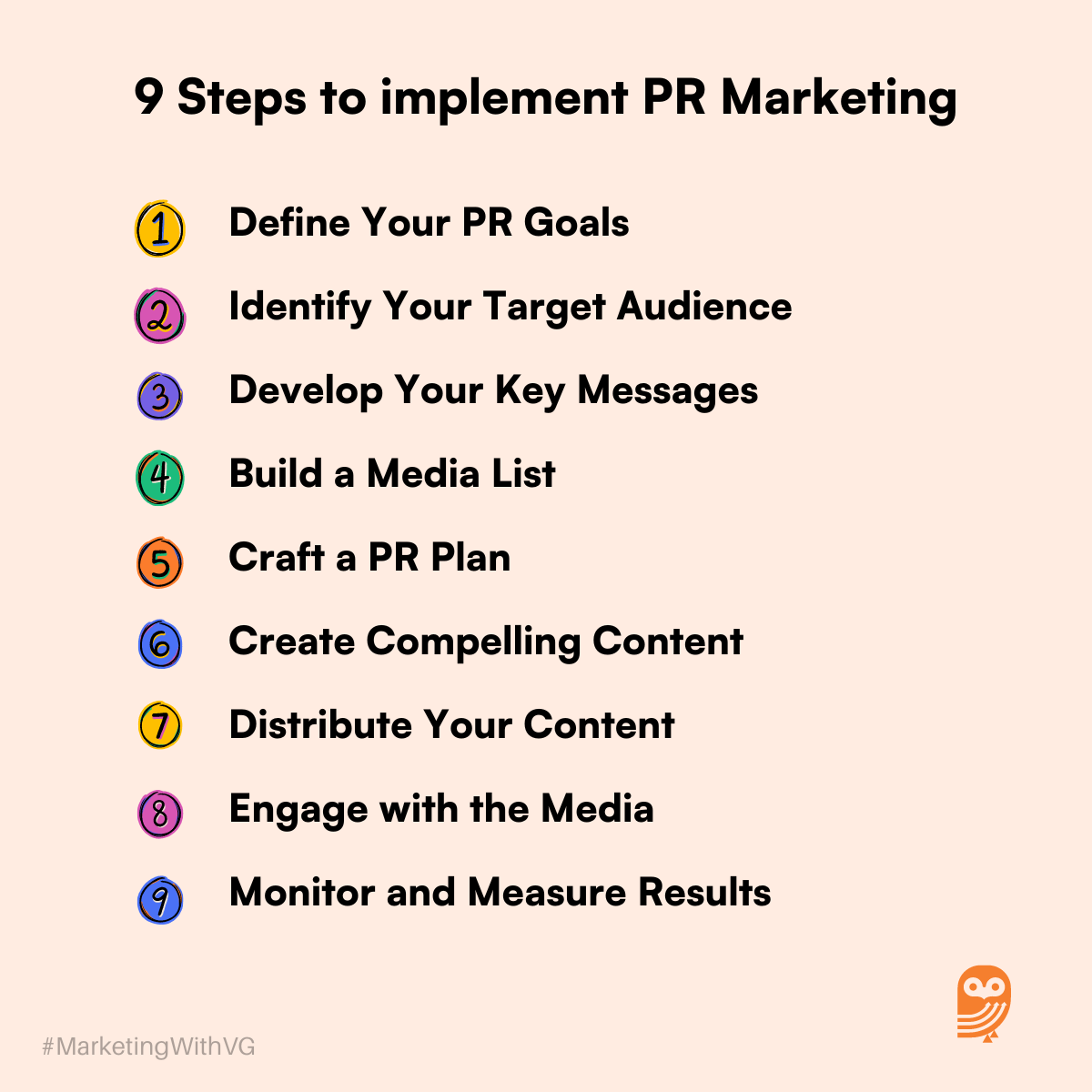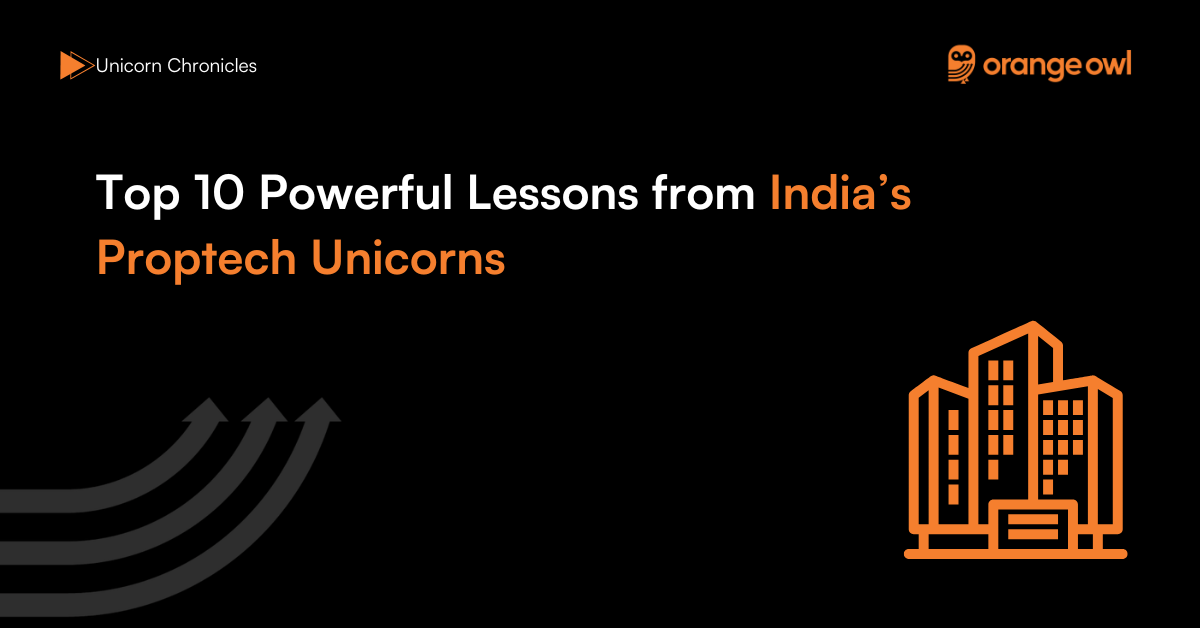What is Effective B2B PR Marketing and how to Implement?: A Complete Guide
Vivek Goel
July 3, 2024

Table of Contents
Introduction
Public Relations (PR) plays a crucial role in shaping the perception of a business. For B2B (Business-to-Business) companies, effective PR strategies can drive brand recognition, build trust, and ultimately lead to business growth. This comprehensive guide will delve into the essentials of B2B PR marketing, from understanding what PR is, to the step-by-step guide for implementing it, current trends, expert tips, best practices, common pitfalls, and essential dos and don’ts.
What is PR?
Public Relations (PR) is a strategic communication process that builds mutually beneficial relationships between organizations and their publics. In the context of B2B, PR focuses on establishing and maintaining relationships with other businesses, industry influencers, and media outlets.
Key Components of B2B PR Marketing
- Media Relations: Engaging with journalists and media outlets to gain coverage.
- Content Creation: Crafting press releases, articles, blogs, and other content to share news and information.
- Crisis Management: Handling unexpected events that could negatively impact the company’s reputation.
- Event Management: Organizing and promoting events to enhance visibility and engagement.
How is PR Useful for B2B?
PR offers several benefits for B2B companies, including:
- Building Brand Awareness: Consistent PR efforts can significantly boost brand recognition among target audiences.
- Establishing Credibility: Positive media coverage and thought leadership content help establish a company as an industry leader.
- Influencing Decision Makers: Effective PR strategies can influence potential clients, partners, and investors.
- Enhancing SEO: Quality backlinks from reputable publications can improve search engine rankings.
Step-by-Step Guide to Implement B2B PR

1. Define Your PR Goals
Defining clear PR objectives is the foundation of any successful PR strategy. These goals should align with your overall business objectives and provide a clear direction for your PR activities. Here’s how to go about it:
Increasing Brand Awareness
- Objective: Enhance the visibility of your brand in the market.
- Tactics: Regular press releases, thought leadership articles, media appearances, and social media campaigns.
- Metrics: Media mentions, website traffic, social media followers, and engagement rates.
Generating Leads
- Objective: Use PR to attract potential clients and generate sales leads.
- Tactics: Publishing case studies, whitepapers, and success stories; hosting webinars and events; securing media coverage in industry publications.
- Metrics: Number of leads generated, conversion rates, and sales growth.
Building Thought Leadership
- Objective: Position your company as a leader and expert in your industry.
- Tactics: Contributing articles to industry publications, speaking at conferences, participating in panel discussions, and publishing research reports.
- Metrics: Speaking engagements, published articles, citation of your content, and recognition from industry peers.
Managing Reputation
- Objective: Maintain and protect your company’s reputation.
- Tactics: Crisis communication planning, proactive media relations, monitoring and responding to online reviews and social media mentions.
- Metrics: Sentiment analysis, volume of negative/positive mentions, and crisis resolution times.
2. Identify Your Target Audience
Understanding who your audience is will help you tailor your PR efforts effectively. Here are the steps to identify your target audience:
Potential Clients
- Profile: Businesses that might need your products or services.
- Research: Use market research and customer data, and industry reports to understand their needs and pain points.
- Engagement: Tailor your PR messages to address their specific challenges and showcase your solutions.
Industry Analysts
- Profile: Experts who influence opinions and decisions within your industry.
- Research: Identify key analysts who cover your industry and follow their publications and reports.
- Engagement: Share insights and data with them, invite them to events, and build relationships through direct communication.
Media Outlets
- Profile: Journalists, bloggers, and editors who cover your industry.
- Research: Identify relevant media outlets and specific journalists who cover topics related to your business.
- Engagement: Send them tailored pitches, provide exclusive stories, and offer your executives for interviews.
Business Partners
- Profile: Companies and organizations that complement your business or are part of your supply chain.
- Research: Identify potential partners and understand their business models and needs.
- Engagement: Highlight potential collaboration opportunities and mutual benefits in your PR communications.
3. Develop Your Key Messages
Creating clear, consistent, and concise key messages is essential for effective PR communication. Here’s how to develop them:
Clear
- Ensure simplicity: Avoid jargon and use language that is easy to understand.
- Specificity: Be specific about what you offer and how it benefits your audience.
- Examples: Instead of saying “We offer innovative solutions,” say “Our software reduces customer onboarding time by 50%.”
Consistent
- Unified Messaging: Ensure all communications reflect the same core messages.
- Training: Train all spokespeople and employees to use the same messaging.
- Documentation: Create a messaging document that outlines key points and share it with your team.
Concise
- Brevity: Keep your messages short and to the point.
- Focus: Stick to the most important points that you want your audience to remember.
- Examples: Use bullet points and avoid lengthy paragraphs.
4. Build a Media List
A well-curated media list is vital for effective media outreach. Here’s how to build one:
Industry-Specific Journalists
- Research: Identify journalists who write about your industry and topics related to your business.
- Tools: Use media databases like Cision or Muck Rack to find contacts.
- Details: Collect contact information, including email addresses, social media handles, and areas of interest.
Bloggers
- Influence: Identify influential bloggers in your industry.
- Engagement: Follow their blogs, engage with their content, and build relationships by commenting and sharing their posts.
- Outreach: Reach out with personalized pitches that align with their interests and audience.
Influencers
- Profile: Look for industry influencers who have a significant following and credibility.
- Engagement: Build relationships by engaging with their content and offering valuable insights or collaboration opportunities.
- Outreach: Collaborate on content, offer guest posts, or invite them to events.
Trade Publications
- Research: Identify trade publications that are widely read in your industry.
- Contact: Collect editorial contacts and understand their submission guidelines.
- Engagement: Submit articles, press releases, and opinion pieces.
5. Craft a PR Plan
A comprehensive PR plan outlines your strategies, tactics, and timelines. Here’s how to create one:
A Content Calendar
- Plan: Schedule your content creation and distribution activities.
- Components: Include blog posts, press releases, social media posts, and events.
- Timing: Plan content around key dates, industry events, and product launches.
Press Release Schedule
- Regularity: Determine how often you will send out press releases.
- Topics: Plan press releases around major announcements, new products, partnerships, and milestones.
- Coordination: Coordinate with your marketing and sales teams to align announcements with broader campaigns.
Media Outreach Strategy
- Targeting: Tailor your pitches to specific media contacts.
- Personalization: Customize each outreach message to the recipient’s interests and beats.
- Follow-Up: Plan follow-ups to ensure your message is received and considered.
Event Participation Plan
- Selection: Identify key industry events, trade shows, and conferences.
- Participation: Plan your participation, whether as a speaker, sponsor, or exhibitor.
- Promotion: Promote your involvement through press releases, social media, and your website.
6. Create Compelling Content
High-quality content is the backbone of any PR strategy. Here’s how to create it:
Press Releases
- Structure: Follow a standard format with a headline, lead, body, and boilerplate.
- Content: Ensure the content is newsworthy, clear, and concise.
- Distribution: Send press releases to your media list and publish them on your website and social media.
Blog Posts
- Topics: Choose topics that are relevant to your audience and showcase your expertise.
- SEO: Optimize posts for search engines with keywords, meta descriptions, and internal links.
- Frequency: Maintain a consistent posting schedule to keep your audience engaged.
Whitepapers
- Depth: Provide in-depth analysis and research on industry-related topics.
- Value: Offer valuable insights, data, and solutions to your audience’s problems.
- Promotion: Promote whitepapers through your website, email newsletters, and social media.
Case Studies
- Stories: Highlight success stories of your clients using your products or services.
- Details: Include detailed results and benefits achieved.
- Format: Use a structured format with an introduction, challenge, solution, and results.
Infographics
- Visuals: Use visuals to simplify complex information and make it more engaging.
- Shareability: Create infographics that are easy to share on social media and other platforms.
- Content: Ensure the information is accurate and supports your key messages.
7. Distribute Your Content
Effective distribution ensures your content reaches the right audience. Here’s how to do it:
Directly to Media Contacts
- Personalization: Send personalized emails to media contacts with relevant content.
- Follow-Up: Follow up to ensure they received your message and offer additional information.
Press Release Distribution Services
- Services: Use services like PR Newswire, Business Wire, or PRWeb to distribute your press releases.
- Reach: These services help you reach a broader audience and increase your chances of media coverage.
On Your Company’s Website and Blog
- Visibility: Publish all PR content on your website and blog for easy access.
- SEO: Optimize content for search engines to attract organic traffic.
Via Social Media Platforms
- Channels: Share content across your social media channels, including LinkedIn, Twitter, and Facebook.
- Engagement: Engage with your audience by responding to comments and questions.
8. Engage with the Media
Building strong relationships with media professionals is crucial for successful PR. Here’s how to engage with them:
Sending Personalized Pitches
- Relevance: Ensure your pitch is relevant to the journalist’s beat and audience.
- Personal Touch: Address the journalist by name and reference their previous work.
- Value Proposition: Clearly explain why the story is important and how it benefits their audience.
Offering Exclusive Stories
- Uniqueness: Offer exclusive stories to select journalists to pique their interest.
- Timing: Provide exclusives ahead of major announcements to give them a lead time.
- Support: Offer additional resources like interviews, data, and visuals to support the story.
Providing Expert Commentary
- Expertise: Position your executives and key employees as industry experts.
- Availability: Make them available for interviews and quotes.
- Proactivity: Offer expert commentary on industry trends, news, and developments.
9. Monitor and Measure Results
Tracking the success of your PR efforts is essential for continuous improvement. Here’s how to do it:
Media Coverage
- Tracking: Use media monitoring tools like Mention, Meltwater, or Cision to track media coverage.
- Analysis: Analyze the volume, sentiment, and reach of your coverage.
- Reporting: Create reports to summarize media coverage and share with stakeholders.
Website Traffic
- Tools: Use Google Analytics to monitor website traffic.
- Metrics: Track metrics like page views, unique visitors, and referral sources.
- Analysis: Identify which PR activities drive the most traffic to your site.
Social Media Engagement
- Platforms: Monitor engagement across all social media platforms.
- Metrics: Track likes, shares, comments, and mentions.
- Analysis: Assess which content resonates most with your audience and why.
Lead Generation
- Tracking: Use CRM tools to track leads generated from PR activities.
- Metrics: Monitor the number of leads, conversion rates, and sales attributed to PR.
- Analysis: Determine the ROI of your PR efforts and identify areas for improvement.
Implementing a successful B2B PR strategy requires careful planning, execution, and monitoring. By following these detailed steps, you can create a comprehensive PR plan that aligns with your business goals, engages your target audience, and delivers measurable results. Remember to stay adaptable and continuously refine your strategies based on data and feedback to achieve sustained success in your PR efforts.
Current Trends in B2B PR Marketing
Staying updated with the latest PR trends is essential for maintaining a competitive edge. Some current trends include:
1. Digital Transformation
The rise of digital media has transformed how PR is conducted. B2B companies are increasingly leveraging online platforms for:
- Press releases
- Webinars
- Virtual events
2. Data-Driven PR
Utilizing data analytics to measure PR effectiveness and adjust strategies accordingly is becoming more prevalent. Tools like Google Analytics and media monitoring software help in tracking:
- Audience engagement
- Media reach
- Sentiment analysis
3. Influencer Collaboration
Collaborating with industry influencers and thought leaders can amplify PR efforts. Influencers can:
- Extend reach
- Enhance credibility
- Drive engagement
4. Content Marketing Integration
Integrating PR with content marketing efforts ensures a cohesive communication strategy. This includes:
- Aligning content themes
- Coordinating publication schedules
- Sharing content across multiple platforms
5. Focus on Sustainability and Social Responsibility
Companies are increasingly highlighting their commitment to sustainability and social responsibility in their PR efforts. This involves:
- Sharing stories about corporate social responsibility (CSR) initiatives
- Highlighting environmentally friendly practices
- Promoting ethical business practices
Top Tips for Effective B2B PR Marketing
1. Know Your Audience
Understand the specific needs and preferences of your target audience to tailor your PR messages effectively.
2. Be Consistent
Maintain consistency in your messaging across all PR channels to build a strong and recognizable brand identity.
3. Leverage Multimedia
Incorporate multimedia elements like videos, images, and infographics to make your content more engaging and shareable.
4. Build Relationships
Invest time in building and nurturing relationships with media professionals and industry influencers.
5. Monitor Competitors
Keep an eye on your competitors’ PR activities to identify opportunities and stay ahead in the industry.
6. Use Data
Leverage data to measure the effectiveness of your PR efforts and refine your strategies for better results.
Best Practices in B2B PR Marketing
1. Align PR with Business Goals
Ensure that your PR objectives are aligned with your overall business goals for maximum impact.
2. Develop a Crisis Communication Plan
Be prepared for potential crises with a well-thought-out crisis communication plan that outlines how to respond to negative events.
3. Be Authentic
Authenticity builds trust. Ensure that your PR messages are genuine and reflect the true values of your company.
4. Focus on Storytelling
Craft compelling stories that resonate with your audience and humanize your brand.
5. Engage in Thought Leadership
Position your company as an industry thought leader by sharing insights, trends, and expert opinions.
Common Pitfalls in B2B PR Marketing
1. Lack of Clear Objectives
Without clear PR objectives, it’s challenging to measure success and demonstrate ROI.
2. Ignoring Data
Neglecting to use data can lead to missed opportunities and ineffective PR strategies.
3. Poor Timing
Timing is crucial in PR. Ensure that your press releases and announcements are well-timed to maximize impact.
4. Overlooking the Audience
Failing to understand your audience’s needs and preferences can result in ineffective PR messages.
5. Inconsistent Messaging
Inconsistent messaging can confuse your audience and dilute your brand identity.
Dos and Don’ts of B2B PR Marketing
Dos:
- Do be proactive: Stay ahead by anticipating trends and preparing for potential issues.
- Do engage with your audience: Use social media and other platforms to interact with your audience regularly.
- Do follow up: After sending a press release or pitch, follow up with media contacts to increase your chances of coverage.
- Do provide value: Ensure that your PR content offers value to your audience, whether through information, insights, or entertainment.
Don’ts:
- Don’t be overly promotional: Focus on providing valuable content rather than purely promotional material.
- Don’t ignore negative feedback: Address negative feedback promptly and professionally to maintain your reputation.
- Don’t neglect offline PR: While digital PR is important, don’t forget traditional PR methods like events and face-to-face networking.
- Don’t be reactive: Don’t wait for issues to arise; be proactive in managing your brand’s reputation.
Conclusion
Effective B2B PR is a multifaceted endeavor that requires a strategic approach, consistent effort, and a keen understanding of your audience and industry. By following the steps outlined in this guide, leveraging current trends, and adhering to best practices, B2B companies can build strong, lasting relationships with their stakeholders, enhance their brand reputation, and drive business success. Remember to continuously monitor and adapt your PR strategies to stay ahead in the ever-evolving landscape of public relations.
Top Frequently Asked Questions (FAQs) on PR Marketing
B2B PR focuses on building relationships and reputation among other businesses, industry influencers, and stakeholders, while B2C PR targets a broader audience, primarily individual consumers. B2B PR emphasizes thought leadership, industry expertise, and long-term relationships, whereas B2C PR often centers on brand image, emotional appeal, and direct consumer engagement.
Measuring ROI in B2B PR can be challenging but achievable by tracking specific metrics:
- Media Coverage: Quantity and quality of mentions in relevant publications.
- Website Traffic: Increases in visits, page views, and unique visitors following PR activities.
- Lead Generation: Number of leads generated from PR campaigns and their conversion rates.
- Social Media Metrics: Engagement rates, followers, and mentions.
- Sales Growth: Increases in sales directly linked to PR initiatives.
A successful B2B PR pitch should include:
- A Compelling Subject Line: Grab the journalist’s attention.
- Personalization: Tailor the pitch to the recipient’s interests and previous work.
- Newsworthiness: Clearly state why the story is relevant and timely.
- Value Proposition: Explain how the story benefits their audience.
- Supporting Data: Include statistics, quotes, and other credible data.
- Call to Action: Offer next steps, such as scheduling an interview or providing additional information.
Effective crisis management involves:
- Preparedness: Have a crisis communication plan in place.
- Rapid Response: Address the issue promptly and transparently.
- Consistent Messaging: Ensure all communications are aligned and consistent.
- Monitoring: Keep track of media coverage and public sentiment.
- Learn and Adapt: Analyze the crisis and improve future strategies.
Social media is vital in B2B PR for:
- Engagement: Direct interaction with industry professionals and stakeholders.
- Content Distribution: Amplifying press releases, articles, and other PR content.
- Brand Building: Enhancing brand presence and reputation.
- Listening: Monitoring industry trends and audience sentiment.
- Networking: Connecting with influencers, journalists, and potential clients.
The frequency of press releases depends on the company’s news and activities. Generally, aim for:
- Monthly Releases: For regular updates and minor announcements.
- Quarterly Releases: For significant milestones, financial reports, and major news.
- Event-Driven Releases: Whenever there is a noteworthy event, such as product launches, partnerships, or industry awards.
Maintaining strong media relationships involves:
- Regular Communication: Keep journalists informed with timely and relevant updates.
- Value Addition: Provide useful and exclusive information.
- Respect: Understand their deadlines and workloads.
- Personal Interaction: Engage through events, calls, and meetings.
- Follow-Up: Always follow up on pitches and thank them for coverage.
B2B companies can leverage industry events by:
- Speaking Engagements: Positioning executives as thought leaders.
- Sponsorships: Enhancing brand visibility and credibility.
- Networking: Building relationships with industry professionals and media.
- Press Coverage: Issuing press releases and arranging media interviews.
- Content Creation: Generating post-event content like blogs, videos, and whitepapers.
Common mistakes in B2B PR include:
- Lack of Clear Objectives: Not having defined PR goals.
- Ignoring Audience Needs: Failing to tailor messages to the target audience.
- Overpromoting: Being too sales-focused rather than providing valuable content.
- Inconsistent Messaging: Sending mixed messages that confuse the audience.
- Neglecting Follow-Up: Not following up on pitches and media interactions.
Integrating PR with other marketing efforts can be done by:
- Aligning Messages: Ensure PR and marketing messages are consistent.
- Coordinating Campaigns: Plan PR activities alongside marketing campaigns.
- Content Sharing: Repurpose PR content for marketing channels.
- Cross-Promotion: Promote PR achievements through marketing efforts.
- Collaborative Teams: Foster collaboration between PR and marketing teams to leverage each other’s strengths.


